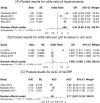Can biomarkers be used to improve diagnosis and prediction of metabolic syndrome in childhood cancer survivors? A systematic review
- PMID: 34258851
- PMCID: PMC8596408
- DOI: 10.1111/obr.13312
Can biomarkers be used to improve diagnosis and prediction of metabolic syndrome in childhood cancer survivors? A systematic review
Abstract
Childhood cancer survivors (CCS) are at increased risk to develop metabolic syndrome (MetS), diabetes, and cardiovascular disease. Common criteria underestimate adiposity and possibly underdiagnose MetS, particularly after abdominal radiotherapy. A systematic literature review and meta-analysis on the diagnostic and predictive value of nine newer MetS related biomarkers (adiponectin, leptin, uric acid, hsCRP, TNF-alpha, IL-1, IL-6, apolipoprotein B (apoB), and lipoprotein(a) [lp(a)]) in survivors and adult non-cancer survivors was performed by searching PubMed and Embase. Evidence was summarized with GRADE after risk of bias evaluation (QUADAS-2/QUIPS). Eligible studies on promising biomarkers were pooled. We identified 175 general population and five CCS studies. In the general population, valuable predictive biomarkers are uric acid, adiponectin, hsCRP and apoB (high level of evidence), and leptin (moderate level of evidence). Valuable diagnostic biomarkers are hsCRP, adiponectin, uric acid, and leptin (low, low, moderate, and high level of evidence, respectively). Meta-analysis showed OR for hyperuricemia of 2.94 (age-/sex-adjusted), OR per unit uric acid increase of 1.086 (unadjusted), and AUC for hsCRP of 0.71 (unadjusted). Uric acid, adiponectin, hsCRP, leptin, and apoB can be alternative biomarkers in the screening setting for MetS in survivors, to enhance early identification of those at high risk of subsequent complications.
Keywords: biomarker; childhood cancer survivors; systematic review; the metabolic syndrome.
© 2021 The Authors. Obesity Reviews published by John Wiley & Sons Ltd on behalf of World Obesity Federation.
Conflict of interest statement
The authors have nothing to disclose.
Figures



References
-
- Howlader N, Noone AM, Krapcho M, et al. SEER Cancer Statistics Review (CSR) 1975–2014, National Cancer Institute: Bethesda, MD 2017.
Publication types
MeSH terms
Substances
LinkOut - more resources
Full Text Sources
Medical
Miscellaneous

